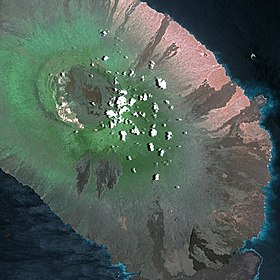Alcedo Volcano
| Alcedo | |
|---|---|

Alcedo Volcano from SPOT Satellite image
|
|
| Highest point | |
| Elevation | 1,130 m (3,710 ft) |
| Coordinates | 0°26′S 91°07′W / 0.43°S 91.12°WCoordinates: 0°26′S 91°07′W / 0.43°S 91.12°W |
| Geography | |
|
|
|
| Geology | |
| Mountain type | Shield volcano |
| Last eruption | December 1993 |
Alcedo Volcano is one of the six coalescing shield volcanoes that make up Isabela Island in the Galapagos. The remote location of the volcano has meant that even the most recent eruption in 1993 was not recorded until two years later. It is also the only volcano in the Galapagos to have erupted rhyolite and basaltic lava.
The volcano has the largest number of wild tortoises of any of the volcanoes in the Galapagos, though their genetic diversity is amongst the lowest of any of the breeds in the archipelago. The habitat of the tortoises was threatened when feral goats crossed from southern Isabela Island in the 1970s and then reproduced rapidly.
It is believed that Alcedo volcano emerged from the sea approximately 313,000 years ago, based on its sub -aerial volume of 234 km3 and average eruption rate of 1x106 m3 per year. This has produced a volcano that is 1130m high with a caldera that measures 6.1 x 7.4 km. Alcedo volcano is similar to its neighbours to the north, Darwin and to the south, Sierra Negra which also have shallow slopes for the majority of their height. It is also similar to these two in that the depth of the caldera is less than 25% of the height of the volcano. This contrasts with the other major shield volcanoes, Cerro Azul, Wolf on Isabela and Fernandina that have much steeper slopes and have calderas that have a depth which is 40-60% of the sub-aerial height.
Alcedo, like the other volcanoes in the Galapagos, has been formed as part of the Galapagos hotspot which is a mantle plume resulting in a hotspot. The volcano is not directly on the hotspot, which is believed to be under the neighbouring island of Fernandina to the west. However, it is still active with the last eruption in 1993. Due to the remoteness of Alcedo historical eruptions are not well recorded. There was an eruption between 1946 and 1960, as determined from variation in photographs. Another eruption in 1954 is now believed to have taken place on neighbouring Sierra Negra. Even the 1993 eruption was not observed at the time and only recorded after an expedition discovered new craters in 1995
...
Wikipedia

